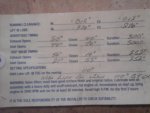More cam related hijack,
I spoke to Clive in Melbourne (over email initially, will have to call him back tomorrow), gave him the spiel;
-Chasing 11~:1
-Elec ignition
-Quad 40mm Carbs
-Stock 73x77
-Stock valves with a 3 angle (33mm in 30mm out)
-4 into 1 exhaust to match what ever cam will work
-Expecting power from 5k
And he came back with,
We would recommend our #0121 profile, which has the following:
Lobe Lift: .276"
Advertised Duration: 305°
Duration @ .050": 240°
Phase Angle: 106.75°
If the profile can be ground straight onto your existing cam as it is, it would cost $207.00, however we may need to weld the lobes in order to put this profile onto your cam, which would cost $801.00 (plus postage, if applicable).
Now for those playing at home, that is very similar to the A3 cossworth cam as listed at Tighe.
https://tighecams.com.au/profiles2/ford1600.htm
And that makes sense with what a lot of you have done prior with the standard valve size in these things.
Suppose from here I'll give him a call and work out what stuff to send him, and we will see if the stock cam is suitable before then worrying about the rest of the rocker gear.
I must say, despite inflation over the years that is still a small amount of coin for how it will change the thing, providing you can fuel and fire it I suppose.
I spoke to Clive in Melbourne (over email initially, will have to call him back tomorrow), gave him the spiel;
-Chasing 11~:1
-Elec ignition
-Quad 40mm Carbs
-Stock 73x77
-Stock valves with a 3 angle (33mm in 30mm out)
-4 into 1 exhaust to match what ever cam will work
-Expecting power from 5k
And he came back with,
We would recommend our #0121 profile, which has the following:
Lobe Lift: .276"
Advertised Duration: 305°
Duration @ .050": 240°
Phase Angle: 106.75°
If the profile can be ground straight onto your existing cam as it is, it would cost $207.00, however we may need to weld the lobes in order to put this profile onto your cam, which would cost $801.00 (plus postage, if applicable).
Now for those playing at home, that is very similar to the A3 cossworth cam as listed at Tighe.
https://tighecams.com.au/profiles2/ford1600.htm
And that makes sense with what a lot of you have done prior with the standard valve size in these things.
Suppose from here I'll give him a call and work out what stuff to send him, and we will see if the stock cam is suitable before then worrying about the rest of the rocker gear.
I must say, despite inflation over the years that is still a small amount of coin for how it will change the thing, providing you can fuel and fire it I suppose.
Last edited:

